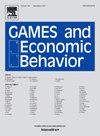市场厚度的匹配效益
IF 1
3区 经济学
Q3 ECONOMICS
引用次数: 0
摘要
大型市场缓解私人信息带来的激励问题的能力一直是大量经济学文献关注的焦点。相比之下,更厚的市场也减少了双重巧合的问题却很少受到关注。将薄市场建模为涉及独立私人价值的双边贸易,将厚市场建模为具有连续交易者的瓦尔拉斯市场,我们分析并量化了市场厚度的匹配效益。这些利益随着产品的精细度而增加,我们将其衡量为在重叠支持区间之外的价值和成本的质量,在重叠支持区间内有贸易的积极收益。对于足够的细度,经营厚市场的利润最大化中介机构的表现优于事后有效的双边贸易。然而,由于双边贸易是一种外部选择,利基产品的贸易商最容易受到中介机构市场力量的影响。扩展考虑了操作厚市场和有限厚市场的固定成本。本文章由计算机程序翻译,如有差异,请以英文原文为准。
The matching benefits of market thickness
The ability of larger markets to mitigate the incentive problem created by private information has been the focus of a sizable economics literature. In contrast, the fact that thicker markets also reduce the double coincidence of wants problem has received little attention. Modeling thin markets as bilateral trade involving independent private values and thick markets as Walrasian markets with a continuum of traders, we analyze and quantify the matching benefits of market thickness. These benefits increase with the nicheness of a product, which we measure as the mass of values and costs outside an interval of overlapping support where there are positive gains from trade. For sufficient nicheness, profit-maximizing intermediaries operating thick markets outperform ex post efficient bilateral trade. However, with bilateral trade as an outside option, traders of niche products are most vulnerable to intermediaries' market power. Extensions consider fixed costs of operating thick markets and finitely thick markets.
求助全文
通过发布文献求助,成功后即可免费获取论文全文。
去求助
来源期刊

Games and Economic Behavior
ECONOMICS-
CiteScore
1.90
自引率
9.10%
发文量
148
期刊介绍:
Games and Economic Behavior facilitates cross-fertilization between theories and applications of game theoretic reasoning. It consistently attracts the best quality and most creative papers in interdisciplinary studies within the social, biological, and mathematical sciences. Most readers recognize it as the leading journal in game theory. Research Areas Include: • Game theory • Economics • Political science • Biology • Computer science • Mathematics • Psychology
 求助内容:
求助内容: 应助结果提醒方式:
应助结果提醒方式:


